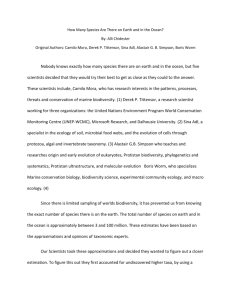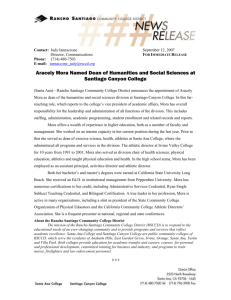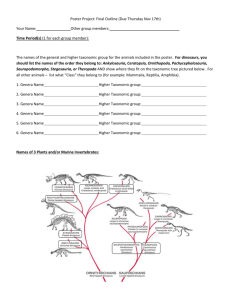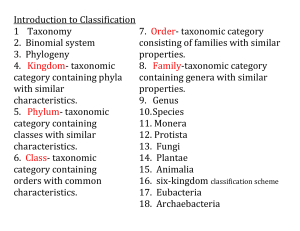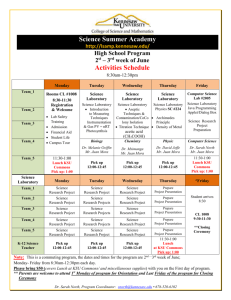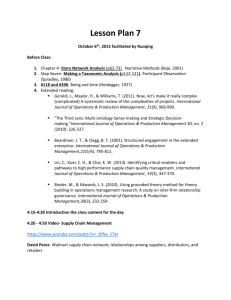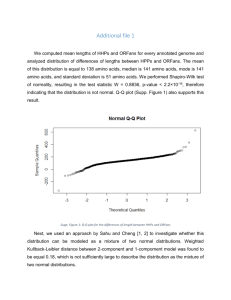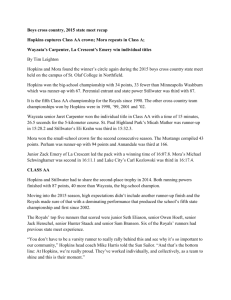Article Summary 2 Name: Kyle Ahn
advertisement
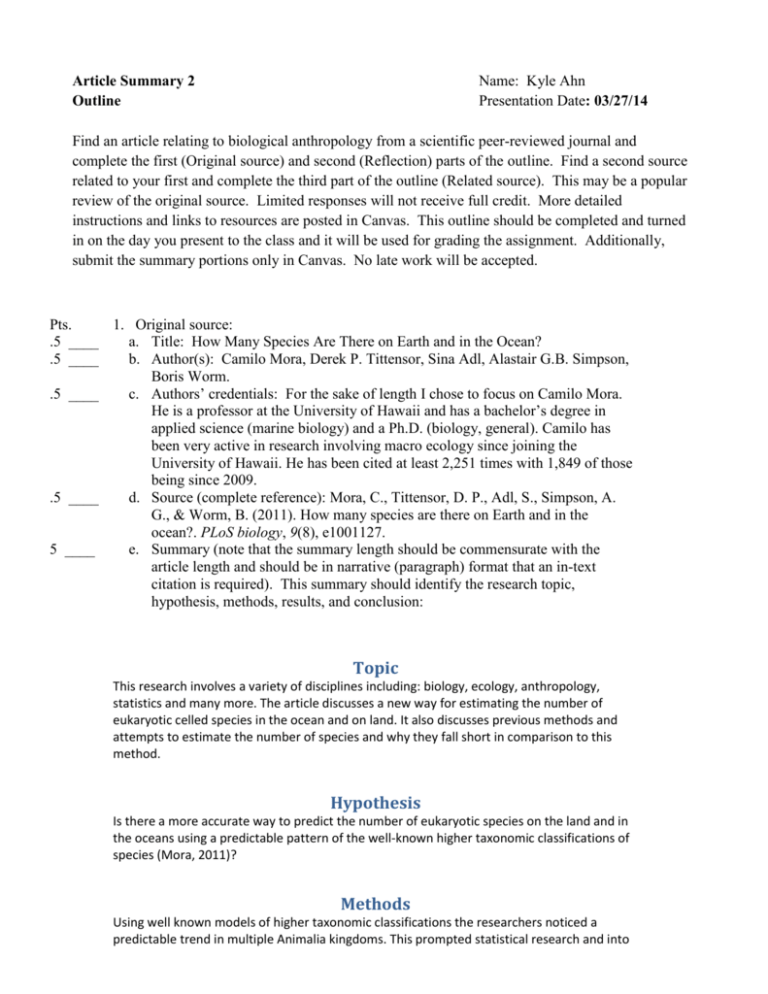
Article Summary 2 Outline Name: Kyle Ahn Presentation Date: 03/27/14 Find an article relating to biological anthropology from a scientific peer-reviewed journal and complete the first (Original source) and second (Reflection) parts of the outline. Find a second source related to your first and complete the third part of the outline (Related source). This may be a popular review of the original source. Limited responses will not receive full credit. More detailed instructions and links to resources are posted in Canvas. This outline should be completed and turned in on the day you present to the class and it will be used for grading the assignment. Additionally, submit the summary portions only in Canvas. No late work will be accepted. Pts. 1. Original source: .5 ____ a. Title: How Many Species Are There on Earth and in the Ocean? .5 ____ b. Author(s): Camilo Mora, Derek P. Tittensor, Sina Adl, Alastair G.B. Simpson, Boris Worm. .5 ____ c. Authors’ credentials: For the sake of length I chose to focus on Camilo Mora. He is a professor at the University of Hawaii and has a bachelor’s degree in applied science (marine biology) and a Ph.D. (biology, general). Camilo has been very active in research involving macro ecology since joining the University of Hawaii. He has been cited at least 2,251 times with 1,849 of those being since 2009. .5 ____ d. Source (complete reference): Mora, C., Tittensor, D. P., Adl, S., Simpson, A. G., & Worm, B. (2011). How many species are there on Earth and in the ocean?. PLoS biology, 9(8), e1001127. 5 ____ e. Summary (note that the summary length should be commensurate with the article length and should be in narrative (paragraph) format that an in-text citation is required). This summary should identify the research topic, hypothesis, methods, results, and conclusion: Topic This research involves a variety of disciplines including: biology, ecology, anthropology, statistics and many more. The article discusses a new way for estimating the number of eukaryotic celled species in the ocean and on land. It also discusses previous methods and attempts to estimate the number of species and why they fall short in comparison to this method. Hypothesis Is there a more accurate way to predict the number of eukaryotic species on the land and in the oceans using a predictable pattern of the well-known higher taxonomic classifications of species (Mora, 2011)? Methods Using well known models of higher taxonomic classifications the researchers noticed a predictable trend in multiple Animalia kingdoms. This prompted statistical research and into the estimation of the number of species on our planet. The researchers produced mathematical models that showed an asymptotic trend primarily on phylum that corresponded to the accurate number of well documented taxonomic groups and species. This mathematical model allowed them to predict the number of species within a range of accuracy. Limitations There are many limitations associated with this kind of work. First and foremost is the lack of ability to determine the absolute accuracy or even relative accuracy of the research. In the end it is a probability scenario, however this does not mean we should not try to understand this better. Another problem involves the definition of species. Multiple disciplines use different definitions of taxonomic communities (Mora, 2011); this creates an issue with comparability across the disciplines. Changes in higher taxonomy brackets will affect the data as time goes on. There is no doubt that as time goes on better technology will allow us to better classify living things through taxonomy. These changes affect the raw data used in this research and therefore must continue to be considered as time passes (Mora, 2011). The subjectivity of the Linnaean system of classification (Mora, 2011) is also a limitation. Different people interpret the ground rules differently and therefore see the higher taxonomic classifications differently and this no doubt also affects the raw data used in this mathematical model. Results The results could be written, yet with how quantitative the results are I believe that the table the journal provides is the best description of their results. Note that the discrepancy margin is primarily due to the mathematical model and the limitations it faces. Conclusion “Our current estimate of ~8.7 million species narrows the range of 3 to 100 million species suggested by taxonomic experts and it suggests that after 250 years of taxonomic classification only a small fraction of species on Earth (~14%) and in the ocean (~9%) have been indexed in a central database.” (Mora, 2011). The researches acknowledge that closing the gap is a process that will take a lot more time as evident by the relatively short time we have had to classify living things. However, constant pursuance of this goal is the only way to progress and they believe that this research has done this more accurately than previous estimations. The researches state the importance of this kind of work and quantify the amount of effort it would take to accurately achieve the actual number: “describing Earth's remaining species may take as long as 1,200 years and would require 303,000 taxonomists at an approximated cost of US$364 billion. With extinction rates now exceeding natural background rates by a factor of 100 to 1,000, our results also suggest that this slow advance in the description of species will lead to species becoming extinct before we know they even existed. High rates of biodiversity loss provide an urgent incentive to increase our knowledge of Earth's remaining species.” (Mora, 2011). (Mora, 2011). 1 ____ 1 ____ 1 ____ 1 ____ 2 ____ f. Critical evaluation (what makes this source credible? Why should this information be believed?): First the journal (Public Library of Science) is a nonprofit journal and the authors also state that there are no competing interests of theirs. The journal is well read and this article has 172,341 views and multiple citations and saves. The authors also state the most detrimental limitations to their research within the paper itself. If they have any motive it seems as if they want more researchers to pursue this topic and prove them wrong. It seems as if their main motivation is in the name of science that may be lost by waiting to farther our knowledge of the species on our own planet. g. Relevance to biological anthropology: This is extremely relevant to physical anthropology because although we have spent much of our time recently talking about primates we must not forget that this is a taxonomic classification that we are studying. This research is primarily research done on a taxonomic scale. Taxonomy was an important basis for understanding the process that lead science toward evolutionary processes. Without Linnaeus and his system for classification physical anthropology may not be where it is today. (Chapter 2 in our book). h. Other disciplines touched upon: This article touched on biology and the biological information we may lose by not acting to more accurately and wholly document existing species. We have so much to learn from the biology of other species and in fact that is where an astounding amount of new medicines come from. The biodiversity of our planet could be the key to the cure to so many diseases. i. Synthesis i. In one sentence, summarize the main point of the article: the “take-away message”. Understanding the actual amount of the biodiversity on our planet is extremely important to the future of so many sciences and the estimation of the physical number is a good place to start. 2. Reflection a. Which part of this assignment was most difficult and why? The article itself was very intriguing and although I thoroughly believe it was based on science the topic made it very hard to identify the processes. The article was a spring board for the scientific process. This is a spring board because the results itself is actually the hypothesis for future research. However, with present technology it is very hard to go out and test this hypothesis. b. Identify at least one question you have after reading the original article and explain how you could go about finding an answer. Where can we go from here? I believe the need is clear but the task is tall. If we have really only scratched the surface of documentation how do we continue? It seems as if the present way of doing this business isn’t very efficient. An article addressing the efficiency of Linnaean classification and research may be a good place to start. c. Reflect on how the critical evaluation process impacted your opinion on the article. My critical evaluation allowed me to understand that this article was not following the scientific process itself. It was lending itself to a future hypothesis that may be tested as new processes and technology become available. The research is rooted in mathematics and not necessarily the scientific process, yet the line between the two is a blurred one. d. How might the information in the article be useful in the future? This might be answered very broadly such as how an understanding of larger biological principles might be useful. I’ve touched on the answer to this question multiple times already. The researchers conclusion is actually the beginning of a hypothesis scientists may choose to test in the future as our ability to explore and classify species gets better. 3. Related source .5 ____ a. Title: Why Worry about How Many Species and Their Loss? .5 ____ b. Author(s): Robert M. May .5 ____ c. Authors’ credentials: Bachelor’s degree in both chemical engineering and theoretical physics. Also a P.H. D in theoretical physics. He is currently a professor of zoology at Oxford. He has been cited 96,155 times with 30,000 since 2009. d. Complete reference: May RM (2011) Why Worry about How Many Species and Their Loss? PLoS Biol 9(8): e1001130. doi:10.1371/journal.pbio.1001130 e. Summary (note that the summary length should be commensurate with the article length and should be in narrative (paragraph) format and that an in-text citation is required): This article is in direct response to the Mora article. He poses the question about why it matters. He only regrets that the Mora system does not include the rate at which we are losing species to extinction (May, 2011). He also states a problem this system points out in a subtle way: taxonomic efforts are divided into a ratio of 1:1:1 between “vertebrates, plants, and invertebrates, whereas plant species are roughly 10 times, and invertebrates 100 times, more numerous than vertebrates.” (May, 2011) May also points out that one physicist (name withheld) likened the taxonomic process of trying to document organisms to stamp collecting (May, 2011). Sure 3 ____ 1 ____ 1 ____ it looks nice but what does it matter? May answers the question specifically: “In the 1970s Yuan Longping, “the father of rice”, discovered in the wild a new variety of rice, whose cross with a conventional strain led to a new variety that is 30% more efficient.” (May, 2011) f. Critical evaluation (what makes this source credible? Why should this information be believed?): It is from the same journal as previously described. Yet I think May’s credentials are beyond recognizable. His long standing research history and sheer number of citations speaks for itself. Any basic research into this man clearly shows his credentials. g. Relevance to chosen article: It is in direct response to Mora’s article and criticism to the stated purpose of increasing taxonomic classifications and the importance of doing such. It is not a scientific article but more of an opinion of a well-respected man. It is an endorsement of the research and the purpose of publishing it (to broaden our understanding of biodiversity on our planet).



